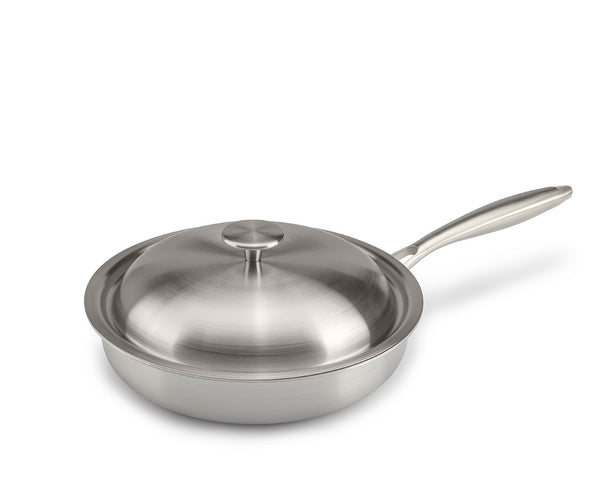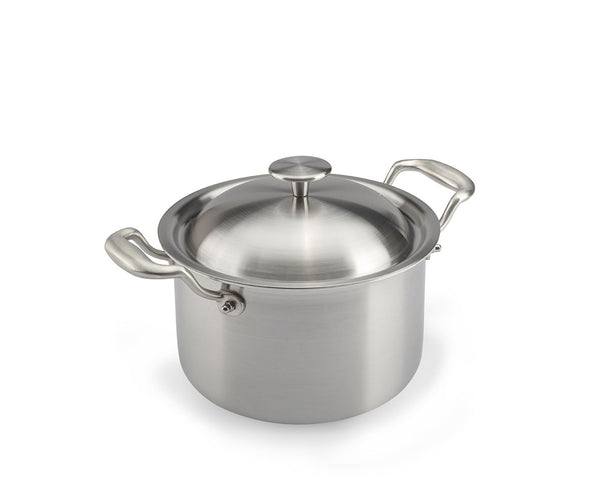The non-stick coating of the cookware is made up of several layers of PTFE that coat a Metal structure, mostly aluminum. The number of layers can vary, as well as the thickness of the underlying metal, and these two elements determine the quality of the pan.
The main food and health safety agencies – EFSA and EPA – agree in stating that the non-stick pans do not present health risks under two conditions
- good quality (weight/thickness is a good indicator),
- correct use (that is, following the manufacturers' instructions)
Other research conducted by the Food and Drug Administration (FDA) has confirmed the safety of PTFE-based coatings. The US agency also reassures about the possible ingestion of residue material, which would be essentially harmless. The Institute of Chemistry and Polymer Technology of the CNR in Naples also agrees that the material – if produced in compliance with European regulations and used correctly – is stable and essentially safe, at least in the absence of significant abrasions and up to reaching particularly high temperatures, higher than those of the most common cooking.
In the text ‘Safety of non-stick coatings’ on the website of one of the most important non-stick brands, it is reiterated that non-stick coatings are safe if used correctly, that is by avoiding
- Heating pans dry (that is, without oil or food inside) at high temperature
- Putting them in the oven above 260° degrees
- Grilling food at the temperature normally used for this type of cooking (260-288 °C)
It is also warned that non-stick coatings may not be safe for small pets, especially birds, therefore it is advised not to expose them to fumes from non-stick pans during cooking, especially if you are not sure to follow the correct usage instructions.
So why has concern about the safety of non-stick coatings spread?
Certainly, the fact that usage limitations are indicated does not help to reassure. But there is more. In the past, the coating of pans was considered potentially dangerous by the entire scientific community due to the content of PFOA (perfluorooctanoic acid). Only starting from July 2020 Delegated Regulation (EU) 2020/784 has prohibited its manufacture, placing on the market, and use.
Recently (March 2022), however, a test on some non-stick pan models conducted in France on behalf of ‘60 Millions de consommateurs’ (published by the National Consumer Institute), found traces of PFOA in some of them, even if in minimal amounts. All models, however, bore the label ‘PFOA Free’! Other perfluorinated compounds subject to health evaluation were also detected.
Furthermore, in commercial non-stick coatings the PFOA has been replaced by other chemical components called Gen-X (belonging to the PFAS category) whose safety for health is still controversial; in fact, the European Chemicals Agency (ECHA) has classified them as substances of concern.
Ceramic coatings are part of the same family of perfluoroalkyl or polyfluoroalkyl compounds (PFAS) suspected of having problematic health effects, similar to Gen-X.
More generally, it is concerning that these kitchen utensils mostly lack any information about the composition of their coating.
But what are PFAS?
PFAS are chemical substances produced and used worldwide in various industrial sectors and not only in the non-stick cookware sector: clothing, household products, firefighting products, automotive, food, construction, electronics. Humans can be exposed to PFAS in various ways, including drinking water and food intake: fish, fruit, eggs and egg-based products, even breast milk.
Foods can become contaminated from soils or contaminated water used to grow them, from PFAS accumulated in animals' bodies through feed and water; from food packaging containing PFAS; or even from equipment containing PFAS used in food processing.
Exposure to these substances causes harmful health effects that are more significant for newborns and children in general.
Experimental studies on animals (mainly mice or rats) indicate that these substances can cause alterations in the liver, thyroid, immune system, reproductive system, fetal development, and certain types of neoplasms. Although numerous studies are available on different animal species (in which the liver is the main target of toxicity), linking these conclusions to humans is particularly difficult due to significant differences in the persistence of these substances within the body (much lower in rodents) and the way they cause toxicity (some mechanisms related to PFAS toxicity in animals are not relevant to humans). Recently, experts have considered the most critical effect for human health to be the decreased immune system response to vaccinations. This is a new finding compared to the previous EFSA opinion from 2018 on PFAS, which considered increased cholesterol the main critical effect.
https://www.mite.gov.it/sites/default/files/archivio/allegati/reach/progetto_PFAS_sintesi.pdf
https://www.efsa.europa.eu/it/news/pfas-food-efsa-assesses-risks-and-sets-tolerable-intake
https://echa.europa.eu/it/hot-topics/perfluoroalkyl-chemicals-pfas





